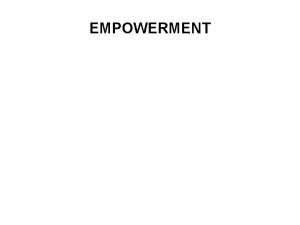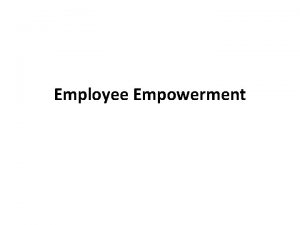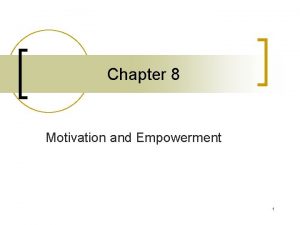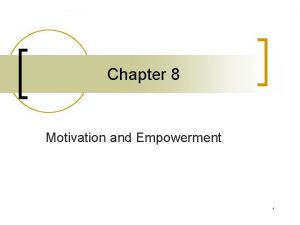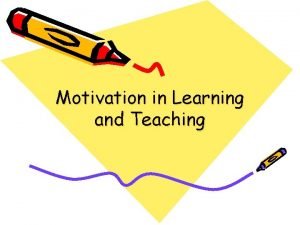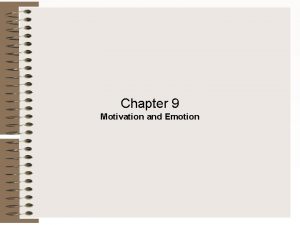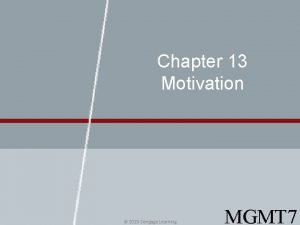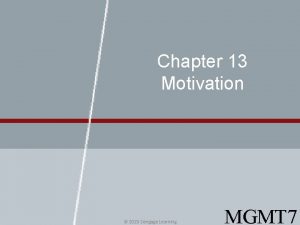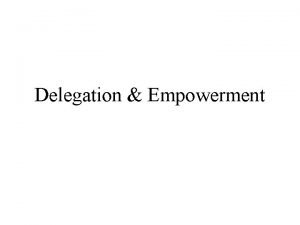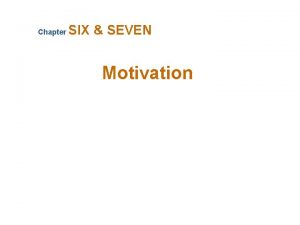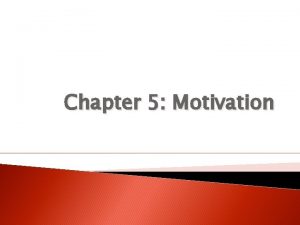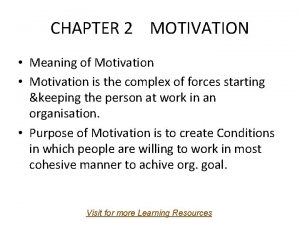Chapter 8 Motivation and Empowerment 2015 Cengage Learning
















- Slides: 16

Chapter 8 Motivation and Empowerment © 2015 Cengage Learning. All Rights Reserved. May not be scanned, copied or duplicated, or posted to a publicly accessible website, in whole or in part. 6 e

Learning Objectives • Recognize and apply the difference between intrinsic and extrinsic rewards • Tap into the motives that induce people to take action to accomplish important goals • Motivate others by meeting their higher-level needs • Apply needs-based theories of motivation and understand how the concept of equity applies to motivation © 2015 Cengage Learning. All Rights Reserved. May not be scanned, copied or duplicated, or posted to a publicly accessible website, in whole or in part. 2

Learning Objectives • Describe the psychological and structural elements of empowerment and how empowerment contributes to motivation • Apply the job characteristics model to enrich jobs • Identify factors that play a role in employee engagement and use engagement to meet higher level needs © 2015 Cengage Learning. All Rights Reserved. May not be scanned, copied or duplicated, or posted to a publicly accessible website, in whole or in part. 3

Learning Objectives • Build a thriving workforce by giving people a sense of making progress toward meaningful goals © 2015 Cengage Learning. All Rights Reserved. May not be scanned, copied or duplicated, or posted to a publicly accessible website, in whole or in part. 4

Exhibit 8. 1 - A Simple Model of Motivation © 2015 Cengage Learning. All Rights Reserved. May not be scanned, copied or duplicated, or posted to a publicly accessible website, in whole or in part. 5

Types of Rewards Intrinsic rewards • Internal satisfactions a person receives in the process of performing a particular action • Appeal to the higher needs of individuals Extrinsic rewards • Given by another person, typically a supervisor • Pay raise and promotions • Appeal to the lower needs of individuals © 2015 Cengage Learning. All Rights Reserved. May not be scanned, copied or duplicated, or posted to a publicly accessible website, in whole or in part. 6

Exhibit 8. 2 - Needs of People and Motivation Methods © 2015 Cengage Learning. All Rights Reserved. May not be scanned, copied or duplicated, or posted to a publicly accessible website, in whole or in part. 7

Exhibit 8. 3 - Four Categories of Motives Source: Based on Bruce H. Jackson, “Influence Behavior: Become a Master Motivator, ” Leadership Excellence (April 2010), p. 14 © 2015 Cengage Learning. All Rights Reserved. May not be scanned, copied or duplicated, or posted to a publicly accessible website, in whole or in part. 8

Needs-Based Theory of Motivation Hierarchy of needs theory • Maslow’s theory proposes that humans are motivated by multiple needs and those needs exist in a hierarchical order Two-factor theory • Hygiene factors: Involves the presence or absence of job dissatisfiers, such as working conditions, pay, company policies, and interpersonal relationships • Motivators: Involves job satisfaction and meeting higher-level needs such as achievement, recognition, and opportunity for growth Acquired needs theory • Mc. Clelland’s theory proposes that certain types of needs are acquired during an individual’s lifetime • Need for achievement, affiliation, and power © 2015 Cengage Learning. All Rights Reserved. May not be scanned, copied or duplicated, or posted to a publicly accessible website, in whole or in part. 9

Exhibit 8. 4 - Maslow’s Hierarchy of Needs © 2015 Cengage Learning. All Rights Reserved. May not be scanned, copied or duplicated, or posted to a publicly accessible website, in whole or in part. 10

Exhibit 8. 5 - Herzberg’s Two-Factor Theory © 2015 Cengage Learning. All Rights Reserved. May not be scanned, copied or duplicated, or posted to a publicly accessible website, in whole or in part. 11

Other Motivation Theories Reinforcement theory • Looks at the relationship between behavior and its consequences • Behavior modification: Set of techniques by which reinforcement theory is used to modify behavior Expectancy theory • Motivation depends on individuals’ mental expectations about their ability to perform tasks and receive desired rewards Equity theory • People are motivated to seek social equity in the rewards they receive for performance • State of equity - Ratio of one person’s outcomes to inputs equals the ratio of others’ in the work group • Inequity - Input/outcome ratios are out of balance © 2015 Cengage Learning. All Rights Reserved. May not be scanned, copied or duplicated, or posted to a publicly accessible website, in whole or in part. 12

Exhibit 8. 6 - Shaping Behavior with Reinforcement © 2015 Cengage Learning. All Rights Reserved. May not be scanned, copied or duplicated, or posted to a publicly accessible website, in whole or in part. 13

Exhibit 8. 7 - Key Elements of Expectancy Theory © 2015 Cengage Learning. All Rights Reserved. May not be scanned, copied or duplicated, or posted to a publicly accessible website, in whole or in part. 14

Exhibit 8. 8 - The Job Characteristics Model Source: Adapted from J. Richard hackman and G. R. Oldham, “Motivation through the design of Work: Test of a Theory, ” Organizational Behavior Human Performance 16 (1976): 256 © 2015 Cengage Learning. All Rights Reserved. May not be scanned, copied or duplicated, or posted to a publicly accessible website, in whole or in part. 15

Exhibit 8. 9 - The Empowerment Continuum © 2015 Cengage Learning. All Rights Reserved. May not be scanned, copied or duplicated, or posted to a publicly accessible website, in whole or in part. 16
 Chapter 13 medical math assignment sheet cengage learning
Chapter 13 medical math assignment sheet cengage learning Cengage learning chapter 7 answers
Cengage learning chapter 7 answers 2009 delmar cengage learning
2009 delmar cengage learning Cengage learning heart diagram
Cengage learning heart diagram Cengage learning heart diagram
Cengage learning heart diagram South-western cengage learning
South-western cengage learning 2009 delmar cengage learning
2009 delmar cengage learning Cengage learning heart diagram
Cengage learning heart diagram Challenge word building medical terminology
Challenge word building medical terminology Cengage learning australia
Cengage learning australia Measuring and recording apical pulse
Measuring and recording apical pulse Cengage learning
Cengage learning Cengage learning
Cengage learning Wadsworth cengage learning
Wadsworth cengage learning Cengage learning
Cengage learning Cengage learning plant cell
Cengage learning plant cell Cengage learning
Cengage learning

















